| Goat Page by Mike Sandlin |
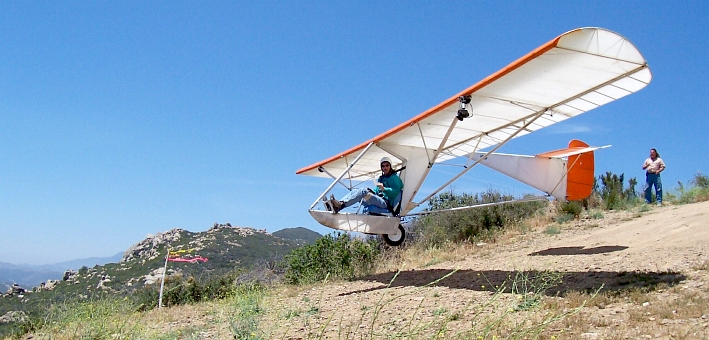
| Last Update: April 28, 2010 |
| Goat Page by Mike Sandlin |

| Last Update: April 28, 2010 |
The Goat is an airchair, essentially a garden chair with a wing. This is Goat4 in March of 2007. |
|
Like the Bug biplanes, the Goat does not foot launch, but is either towed into the air or else launched by rolling down a hillside. My rolling launches are usually made at a site shared with hang gliders and paragliders. This glider has proved to be a worthy soaring aircraft, flying very much like a hang glider and readily adapting to hang glider techniques and procedures. The Goat1 has made a cross country flight of more than sixty miles, reaching an altitude above 13,000 feet.
This is a home built glider, made with a low level of technology (no welding, no special machining, no molds or jigs, no spray rig) from readily available materials (mostly aluminum tubing, steel cable, aircraft bolts and heat shrink fabric). The Goat is a noncommercial project, with no product or plans for sale now or later, but I have posted complete descriptive drawings of the Bug4 and Goat1 through Goat4 on the Web. These drawings are freely available for whatever purpose the user may desire.
|
|
|
|
A careful pilot knows his glider and checks it out before flight. |
|
|
|
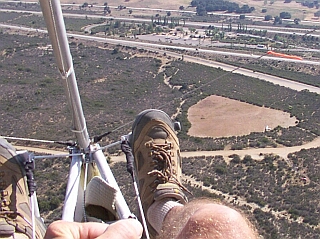 Coming
down to the Landing Zone, Bug2 is already
there
Coming
down to the Landing Zone, Bug2 is already
there |
 Goat1 makes
a rolling takeoff from a gravel Goat1 makes
a rolling takeoff from a gravelhang glider launch ramp |
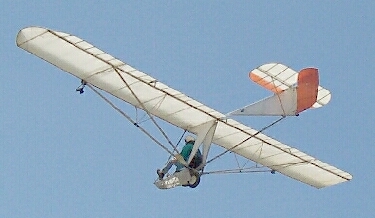
Goat1 in Flight |
The Goat1 made it's first flight on February 1, 2003, and since then has been flying as a weekend soaring glider. It has proven to be a pleasant and practical glider for slope launching and local flying. It is easy to tow behind an ultralight airplane. The struts fold onto the wing for transport. As of december, 2009, Goat1 has new fabric and removable, folding main struts,and is now called the Red Goat.
The biggest drawback to the Goat1 design has been the large size and heavy weight of the main wing panel with regard to loading or unloading it onto a car top rack. I make a point of carrying each wing panel by myself most of the time, and I find it stressful. The folded wing half weighs 42 pounds, which is about my upper limit for something big and bulky that has to be lifted and carried in the wind. The primary reason for the Goat2 design was to have a lighter wing panel to reduce the burden of assembly and loading.
|
|
|
Goat2 was light and eliminated the bulky struts, but all those long cables created their own transport and assembly problems. This led eventually to the creation of Goat4, which retained the cable braced wing but simplified a lot of the assembly mechanics.
|
Goat3 high in a desert thermal |
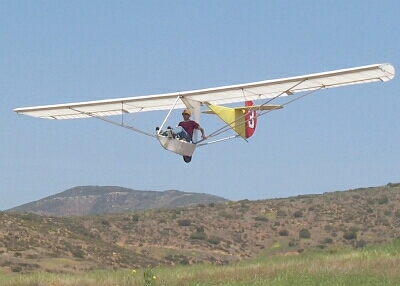
Goat3 in flight, (May 2006) |
Goat3 has a smaller wing than the other Goats, with a fancier, sailplane style airfoil. The struts are removed for transport, and the wing does not have folding panels on the trailing edge. The seat back and shoulder belts are fixed in place on the nose section and do not require attention during assembly.
The reduced wing area of Goat3 forces me to fly faster, and the new airfoil doesn't seem to be producing any dramatic performance improvement. As it stands, it looks as if the larger wing with the simpler airfoil (as used by Goat1 & Goat2) may be a suiperior combination for an airchair. Goat3 probably won't stay up in light conditions as well as the others, which leaves me ( body weight 155 lbs., an average weight pilot?) wanting the larger wing.
Goat4 (see photo, second from top of page) is essentially a Goat2 wing with Goat3 nose and tail.
Goat Features
The varioius Goats have these features:
Unfortunately there is no commercially manufactured glider that can do all of what the Goat does. Homebuilding is fun, but people who just want to fly gliders should be able to "buy and fly" instead. Maybe home built airchairs like the Goats and Bugs will help generate enough interest to allow commercial production of an airchair someday. Whoever might choose to develop and sell airchairs would be in a position to set new standards and make a great contribution to ultralight soaring. I don't yet know of anyone doing this, nor would I be a part of that effort, but I will encourage any moves in that direction.
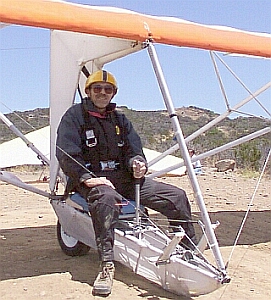
Author in Goat1 |
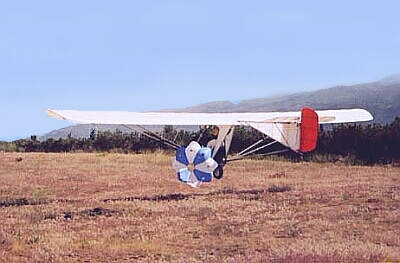 Drogue
Chute Landing
Drogue
Chute Landing |
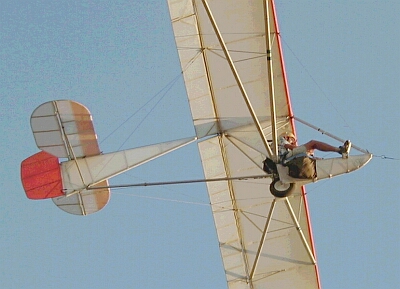
Climbing on a static line, truck tow |
|
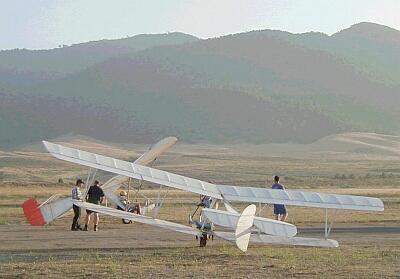
Bug2 and the Goat1 on the airchair flight line, preparing for truck tows.
[END]